Continuous Heart Rate Polar Vantage Battery Life
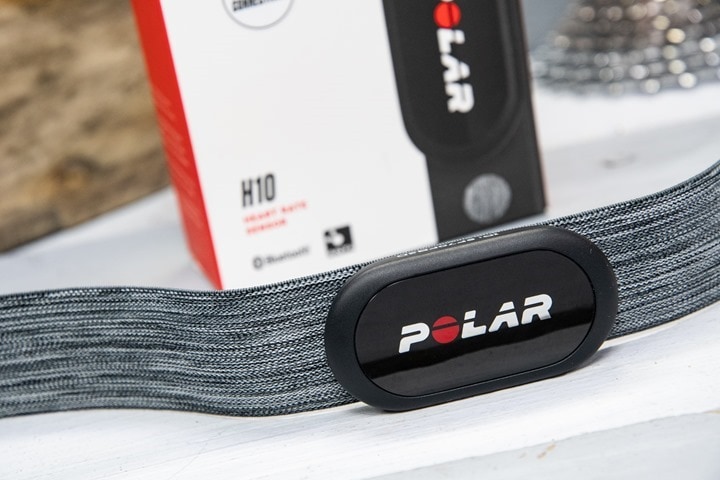
There's arguably no tech product in my arsenal of products that's been used as much as the Polar H10 chest strap, yet I never exactly got around to writing an in-depth review on it. Or, even a short review. In fact, it only had cursory mention when it was announced five years ago. For the most part, the H10 predated when I did dedicated general-purpose heart rate strap reviews.
In fact, the H10 has been around so long that they've announced features, implemented features, and then those features have reached end of life. Such as the also-announced-on-launch-day GoPro integration some 5 years ago, which never made it past the Hero 4/5 cameras (through no fault of Polar). There have been more important features though, like when Polar added ANT+ connectivity to the H10 (via simple firmware update). That update also included dual-Bluetooth connectivity, allowing multiple connections.
And in fact, it's been since around the timeframe that they added ANT+ & dual-Bluetooth integration a few years ago, that my usage has picked up. Prior to that, I only occasionally used it, as I generally preferred straps that could connect to multiple devices (which back then, it was limited to a single Bluetooth connection).
But over the last few years, the H10 and its little brother the H9 have crept further and further into my daily usage. Ultimately, earning itself a place in my mental list of acceptable reference devices for heart rate accuracy, as well as my product buyers guides. Which doesn't mean it's perfect. Like any device, it has its pros and cons. Which, I'll dive into.
Note that in this case, this is a device I bought myself. I've bought far too many H10 straps, either as a bundle or individually. On my trip last week I somehow ended up with three of them in my suitcase. Seriously, I don't even know how. It was like snakes on a plane, but with straps instead. But I have H10's stretching back 5 years or so, and some bought this past year. If you found this review useful, you can use the links at the bottom, or consider becoming a DCR Supporter which makes the site ad-free, while also getting access to a mostly weekly video series behind the scenes of the DCR Cave. And of course, it makes you awesome.
What's In The Box:
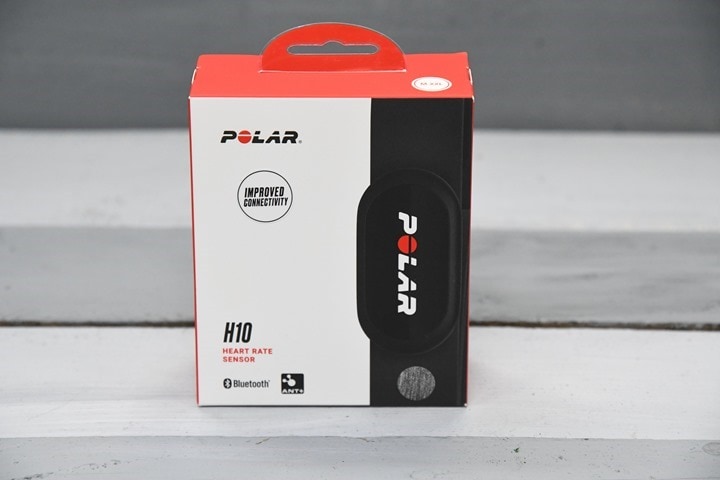
Because I wanted to have this section be up to date, I went out and bought another H10. As if I didn't have enough already. This one is grey though, and I like it – it looks prettier than all my boring black straps. It's the same grey material as the Polar Verity Sense optical HR band.
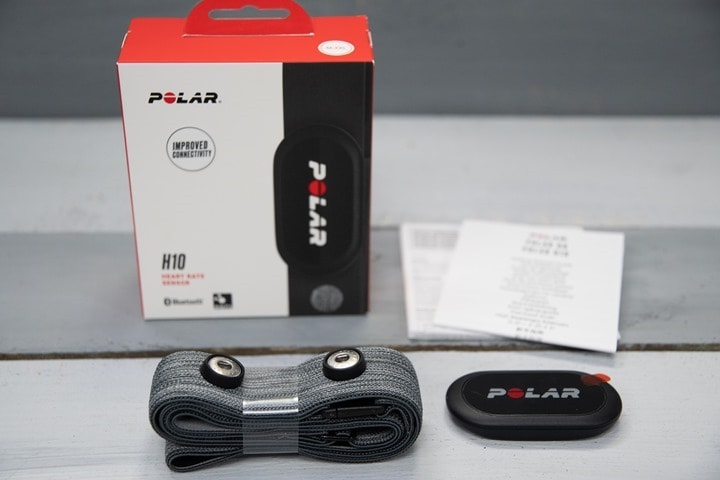
When it comes to sizing, there's basically two sizes of the H10 you can purchase (technically you can also purchase just the strap portion in an XXXL too):
XS-S: 51-66 cm (20"-26")
M-XXL: 65-93 cm (25"-37")
XXXL Strap Portion Only: 76-116 cm (30"-46")
For each of the H10 kits you can purchase either black or the swankier grey one. I've got both, they both technically are identical, but obviously the swankier grey one is sexier. I mean, assuming you can find a heart rate strap sexy. And clearly, since you're here – you do. In the event you're purchasing these straps in person in something called a retail store, the color is indicated by a tiny dot on the packaging.
So, back inside the box, you've got the strap portion folded up in an origami-style situation that you'll never be able to replicate again. And then clipped into the cardboard is the transmitter pod:
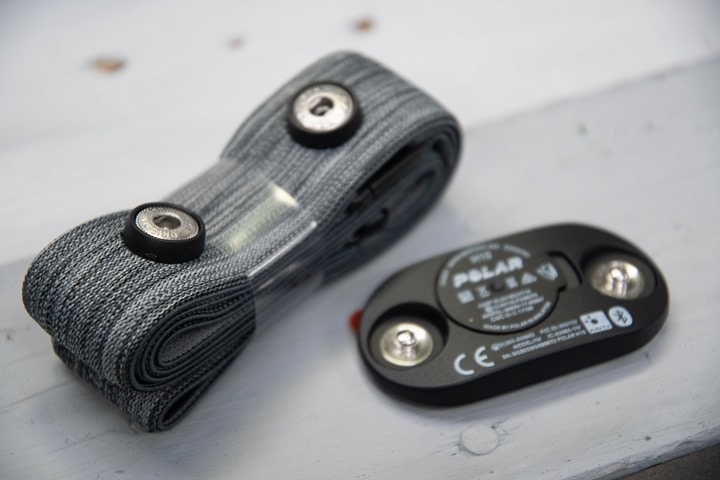
Also, you'll find some paper stuffs in there. It's a manual that tells you not to do unsafe strap things, and to occasionally rinse it off (I usually do so in the shower briefly with water after each workout).
And thus, concludes our unboxing section.
The Basics:
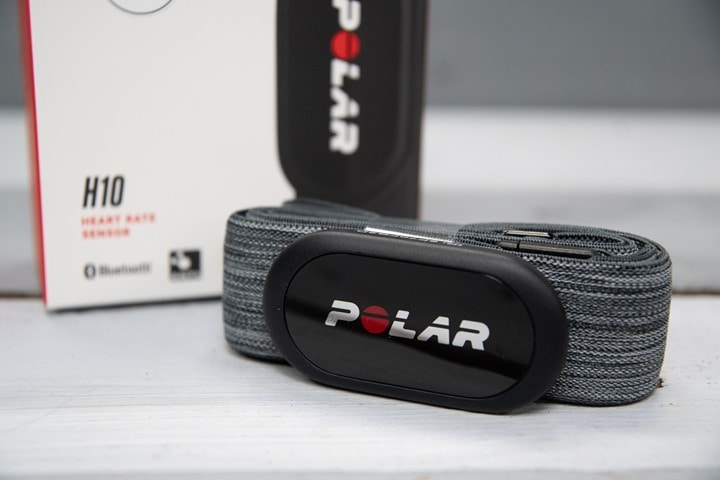
The first thing you'll want to do is pop the pod into the strap. It simply snaps in place using two little button-like thingies. This by itself does not turn the strap on or off, but rather, the strap sensing electrical activity does. Meaning, there's no harm in leaving the pod attached to the strap permanently (as I usually do).
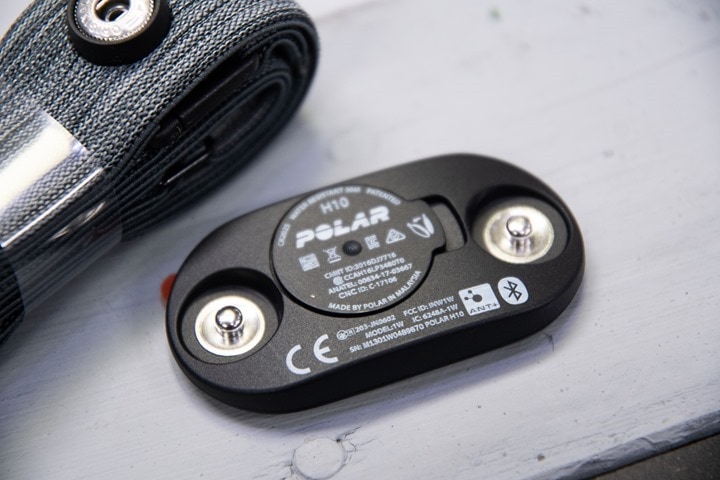
Next, you can adjust the strap length using the small clasp towards one end of the strap. You want a strap reasonably snug. Generally speaking, most people wear it on your chest below the nipple, but some men will wear it above if it starts to slip down. The Polar H10 straps are pretty good about not slipping though, thanks to the tiny little anti-slip dots you see on the strap, which are both on the interior sides and back areas (note that the H9 straps lack these anti-slip dots):

Whereas those smooth sections you see on the strap are where the electrical sensors are, which is where it detects your heart rate. In most conditions, you'll want to moisten these slightly at the beginning of the workout until you start sweating. You can use water, electrode gel, or my personal favorite: licking it. Seriously.
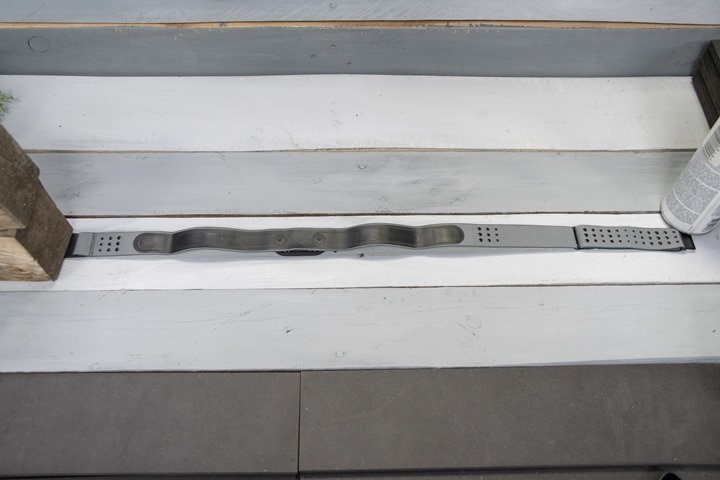
After giving both pads a quick lick, you're ready to snap the clasp on the strap and put it on. Alternatively, I suppose you can put it on first and then lick, though that's slightly more awkward as you hold your shirt up to then appear to passersby to be licking your nipples. Obviously, I choose this route each time.
Now, since this is our first time using the strap you'll want to use either the Polar Beat app or the Polar Flow app to update the firmware. We'll dive into those in a second in the next section. The firmware update is actually super important if you believe the strap may have been sitting on a store shelf for a while, as it might not yet have the firmware update that adds ANT+ connectivity. So don't skip out on that!
Finally, the last thing, before we talk apps and such, is the battery. The unit contains a CR2025 coin cell battery, which roughly has a battery life of about a year of usage. To access the battery, simply pop the back door off (a small flat-blade screwdriver works well), and you'll see the battery compartment.
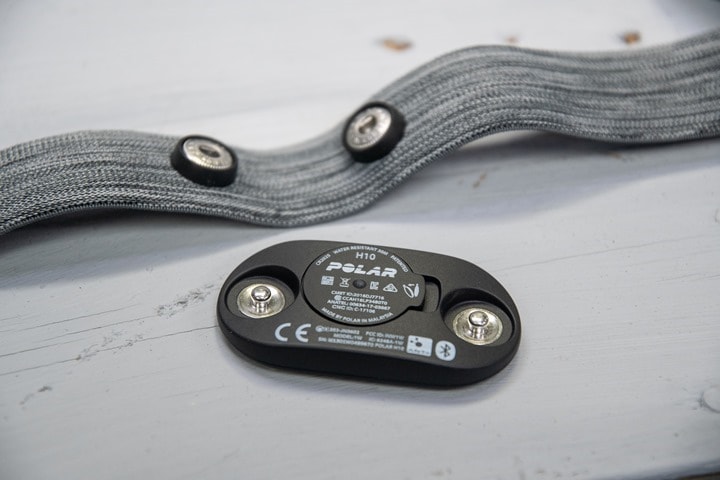
At this juncture you'll ponder how the eff to get that stupid little battery out of the holder without splintering your fingernails, and thus this is where I give you a lifetime pro tip on getting coin cell batteries out: Drop it.
Seriously, take that tiny coin cell battery/holder, and just drop it on the table or ground. I can often do it on the first or second attempt if you hit the angle just right, the battery will happily bounce out.

Then, simply pop the new battery into the pod holder the correct way, and snap that into the transmitter pod. Congratulations, you're now a certified IT professional.
The Polar Apps:
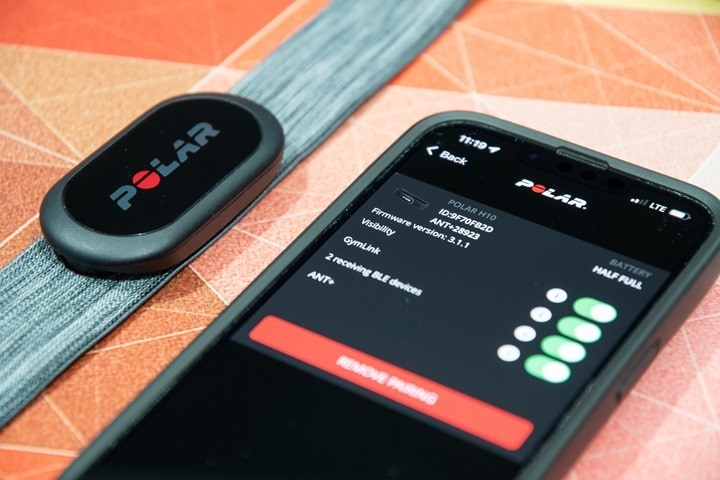
Now as great as the Polar H10 is, it all gets a bit messy here in the apps section. The good news is that for the vast majority of people, you don't need to use the Polar apps (aside from the occasional firmware update).
The reason I say things get messy is that Polar has essentially two apps that interact with their heart rate monitors: Polar Flow and Polar Beat
Polar Flow is where you can manage the Polar H10 within the broader context of your Polar account. For example, it'll notify you of new firmware updates, show the status of the strap, and just generally be there for you to gaze at alongside other Polar devices (e.g. watches) that you might own. Further, you can view the workouts you created from Polar Beat, within Polar Flow – as well as training records longer-term. And as of this year, you can now record workouts in Polar Flow as well as Polar Beat.
Polar Beat is their older app that you can do all the same, plus some paid bits for extra features for Polar watch users (that aren't in Polar Flow). You can toggle settings like ANT+ connectivity, and update the firmware here too. Recorded workouts here end up in Polar Flow. It looks old, it feels old, and in a lot of ways, it acts old. But it gets the job done. Again, most people here are probably using 3rd party apps like Peloton or Strava or whatever to record their data (or a 3rd party device).
I'm not terribly certain which app you're "supposed" to use as the standard/default app for the Polar H10 as the main firmware updater app. So I'll start with Polar Beat, simply because alphabetically it's first. You'll crack it open and create an account if you haven't yet. Then, you can tap on 'HR Sensor' box to search for nearby heart rate sensors. Assuming you're a normal person, you'll only see one in the list:
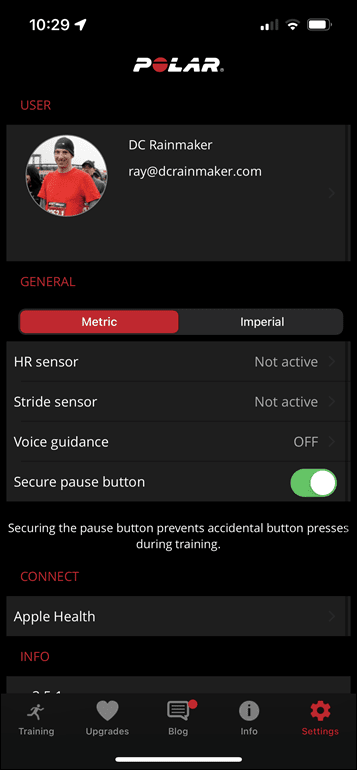
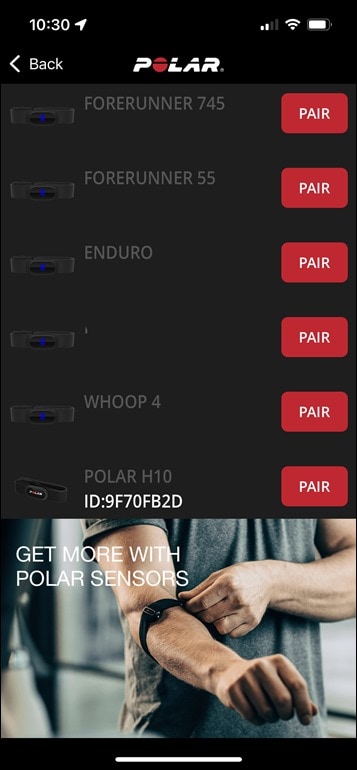
Tap on that blaringly obvious 'Pair' button to get it paired up. That'll cause your phone to confirm your dating intentions, and then the strap will be paired. All of this will take about 2.87 seconds. Now you're done:
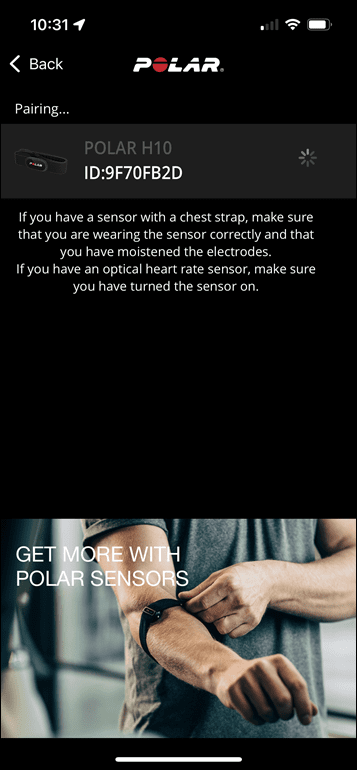
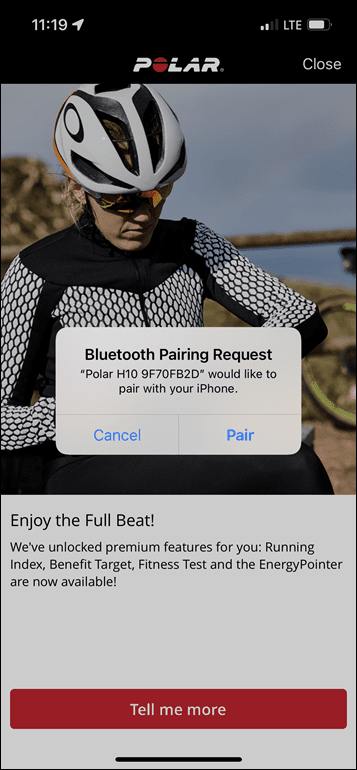
You'll see the current firmware version, and be offered an update if it's behind. More notably, you'll see a toggle for the straps different sensor connectivity options. This includes ANT+, Bluetooth Smart (dual), and Analog (5kHz). The ANT+ one has unlimited connections, as does the analog one. Whereas the Bluetooth Low Energy (aka Bluetooth Smart, aka just Bluetooth) has a maximum of two concurrently transmitting/receiving connections – though unlimited apps can be paired to it. By default, a strap will ship with it only permitting a single connection, so I recommend toggling that to dual, so you don't get yourself in a pickle 6 months from now and have to troubleshoot/remember why.

There's no meaningful battery difference in leaving these all on. The chipset is designed to be super efficient at low energy transmission, so it's not like you're saving any appreciable amount of battery by leaving them on. In fact, Polar is the only company that still even leaves this as an option to toggle.
Next, with that all settled, you can do much the same in the Polar Flow App instead. Here's that same strap showing up after pairing in the Polar Flow app, with the same options. Also, a prompt to update the firmware from Polar Flow for a different strap I have:
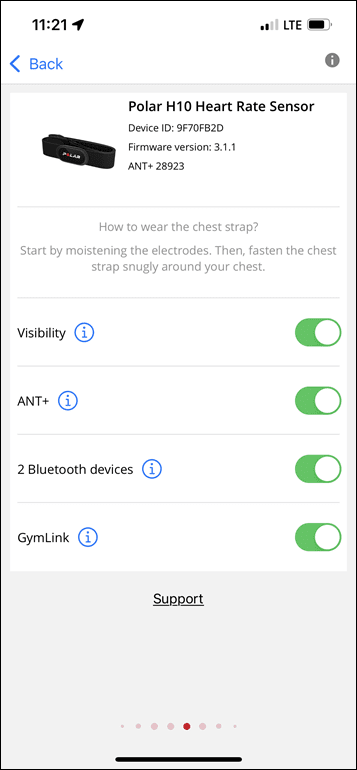
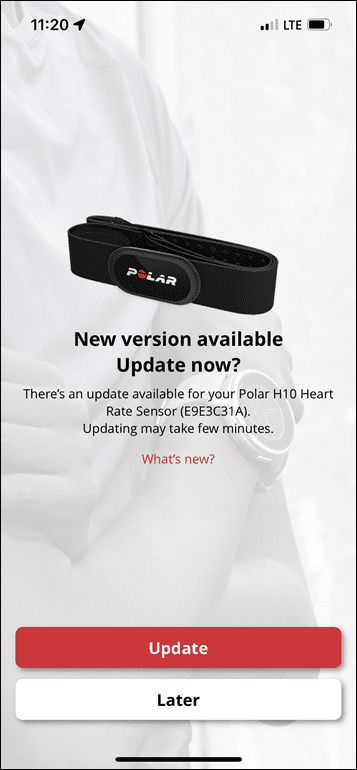
In terms of recording a workout with the Polar app and the H10, you've got two basic categories of options there: With the phone, and without the phone. With the phone is straightforward, since you'll just keep your phone handy and then start the Polar Beat app. You'll choose the sport from a gigantic list of some 100 sports, which have sport-specific calorie profiles. Additionally, the sport will decide whether or not enabling GPS makes sense.
![clip_image001[15] clip_image001[15]](https://media.dcrainmaker.com/images/2021/12/clip_image00115_thumb.png)
![clip_image001[12] clip_image001[12]](https://media.dcrainmaker.com/images/2021/12/clip_image00112_thumb.png)
Once you've done that, you'll see that it automatically connects to your HR strap and if applicable, GPS. Also of note is that in the settings you can connect to Apple Health (and Google Fit presumably like on Android). Whereas on Polar Flow you can connect to 3rd party apps like Strava as well. After tapping start, it'll start recording the workout and show you some basic stats. You'll also get a map shown if it's an outdoor/GPS workout:

![clip_image001[6] clip_image001[6]](https://media.dcrainmaker.com/images/2021/12/clip_image0016_thumb.png)
Afterwards, you'll get some summary information, including data by zones and a track of where you went:
![clip_image001[8] clip_image001[8]](https://media.dcrainmaker.com/images/2021/12/clip_image0018_thumb.png)
![clip_image001[10] clip_image001[10]](https://media.dcrainmaker.com/images/2021/12/clip_image00110_thumb.png)
Now – what if you want to go without your phone? This is useful for scenarios where you want to record your heart rate, but carrying a phone isn't practical, such as swimming, soccer/football, or perhaps just even running. For that, you'll need/use the Polar Beat app, as the Polar Flow app doesn't support it.
To do that, you'll do exactly the same as above to start the workout, then ditch your phone. The H10 will continue to record the workout in its internal memory. To end the session, simply either get back to your phone and tap the end button, which will cause the strap to sync the missing data back to the app. Or alternatively, remove the pod from the strap snaps, which will also end the workout (and keep it off). Once back within range of your phone, you can either rub the pod contacts to wake it up, or put it back on the strap. The Polar Beat app will download all the missing data.
![clip_image001[1] clip_image001[1]](https://media.dcrainmaker.com/images/2021/12/clip_image0011_thumb.png)
At that point the data is accessible like normal – both within the Polar Beat app, as well as the Polar Flow app.
Now, this is the *singular* technical area that Polar could really re-work and improve. Specifically, the requirement to use the phone to start it. For example, while swimming that's messy and sometimes impractical – especially for openwater swimming where you might want to leave your phone elsewhere in a safe/locked place, thus you're starting the workout unnecessarily early, and the Polar app doesn't have any way to crop/shorten the activity afterwards to remove the useless sections. Or, just the realization after you got everything ready to start the workout and remembered you forgot to start the Polar recording. The other challenge is the Polar H10 can only remember/store one workout at a time in memory (though doesn't appear to have a specific duration limitation).
By contrast, arguably my favorite feature on the Wahoo TICKR X (which has downloadable storage as well) is the fact that the strap will *always* create a recorded workout in memory anytime you put it on. It then syncs that to the Wahoo app, and you can simply trim it afterwards in their app (which will even re-upload the trimmed version to 3rd party sites). Like most Wahoo things, it's mind-bogglingly simple, quick, and clean to use. Unfortunately, I've had continued issues with their actual straps (latest version), and thus, I can't recommend them at this point.
Still, this would be an update Polar could make that would significantly improve the end-user experience, both the recording side as well as the app trimming side. The trimming feature would also be handy just in general for Polar's platform, so it could undoubtedly be re-used there too.
Of course, the reality is most people are probably just using 3rd party apps/devices with the Polar H10 anyway, so let's talk about that now.
Connecting to Other Apps/Devices:
As outlined earlier, the Polar H10 supports three basic connectivity types using industry standards to do so:
– ANT+ heart rate (unlimited connections)
– Bluetooth Smart heart rate (two concurrent connections)
– 5kHz analog heart rate (unlimited connections)
For most people, you'll use ANT+ or Bluetooth Smart, with more than likely Bluetooth Smart for smartphone/tablet/etc apps, and ANT+ for things like bike computers or many watches. In general, if your device supports both ANT+ & Bluetooth Smart, I'd recommend using ANT+ for the connectivity type. This is because it won't take up one of your two Bluetooth channels. We'll quickly iterate through some scenarios here.
First up, is pairing to a Polar watch. In this case the Polar Grit X Pro, but it doesn't really matter which one – they all act the same here. Polar watches only support Bluetooth Smart sensors, so you'll go into the sensors menu and search for a sensor. You'll see the Polar H10 listed, along with the ID:
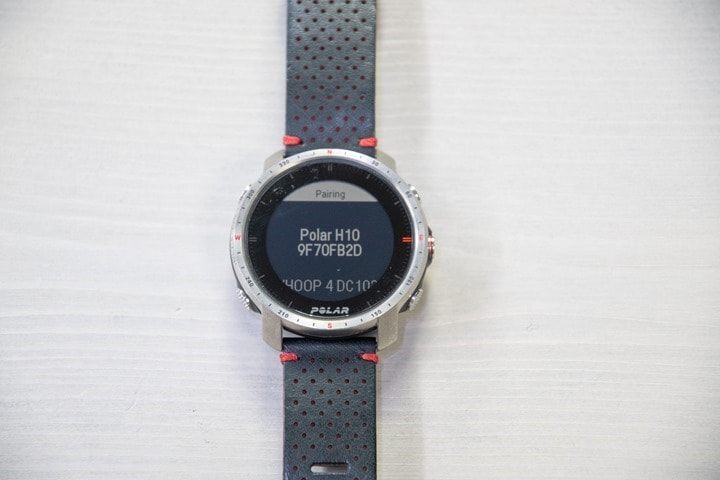
Speaking of which, the ID that's displayed is the same one etched into the top of the strap:

Once you tap to pair it, it'll save it for future use, and automatically connect. In the case of Polar watches, the little HR icon will change slightly to show a strap and the coloring will change to blue:
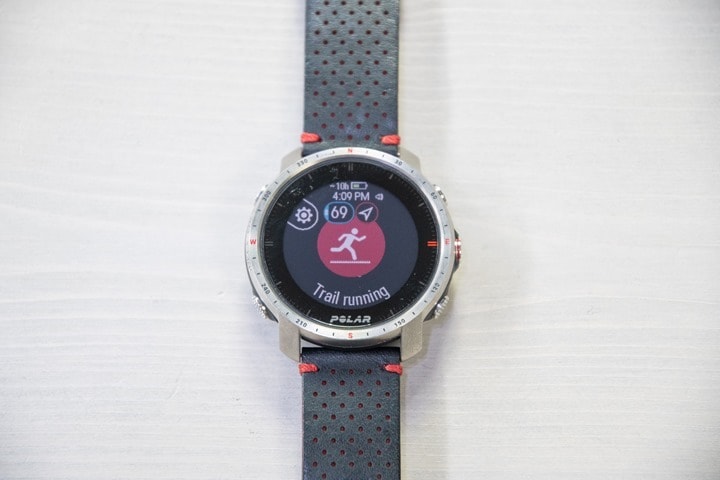
In fact, Polar actually saves your straps in your Polar Flow account and syncs them to all Polar watches automatically.
Here's another Bluetooth Smart example – the Peloton (Bike or Tread, both are identical). When you go into the heart rate strap menu, you can see the Polar H10 listed in there. In the case of Peloton, it can pair to both ANT+ or Bluetooth Smart. So you can choose either. The ANT+ one is listed by the ANT+ ID (which is specified in the Polar Flow and Polar Beat apps).

Next, we've got an ANT+ pairing to a Garmin Edge bike computer. You can see we can search for heart rate sensors, and then there's a menu to show the ANT+ sensors. Once we select that we'll see the ANT+ ID of this H10 strap:
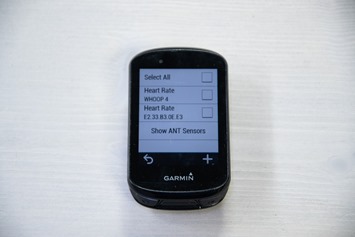
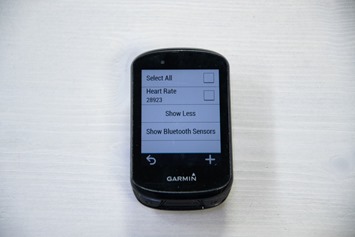
After pairing it up, we can give it a friendly name of our choice:
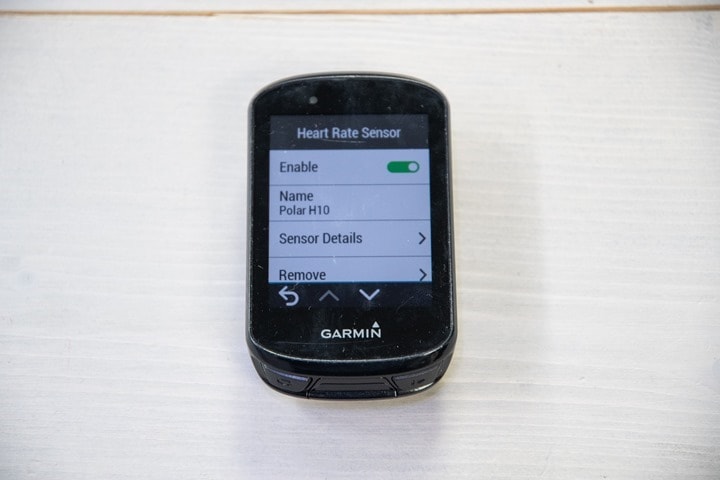
Next, while not really part of the three standards (we'll get to analog in a second), it's worthwhile noting that the Polar H10 is often used for HRV measurement. Here's an example of it paired up to the Elite HRV app, taking an HRV recording:
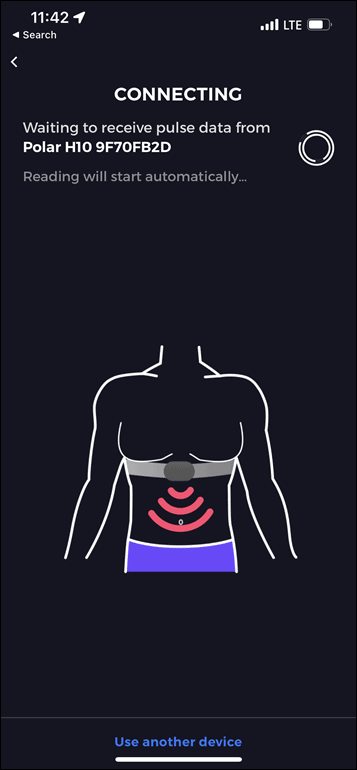
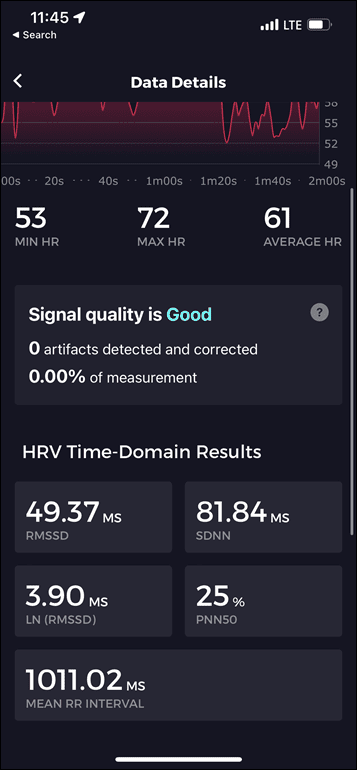
Finally, there's the analog signals. While most companies don't make devices to utilize these anymore, you'll find this on older treadmills and other gym equipment. Generally speaking, you'll move the sensor close-ish to the display, and it'll pair up. Here's my older treadmill, connected up to the analog signal, in a photo from a few years ago:

The analog signals were also popular for transmission within water, as those do transmit in water whereas the digital ANT+ & Bluetooth Smart signals don't transmit through water more than 1-3cm. However, even Polar has stopped supporting that in their watches years ago. So their newest watches can't connect via analog to the H10 (underwater or otherwise).
In fact, somewhat oddly, their watches (especially for their triathlon watches) won't automatically download the data from the Polar H10 if in a swim. Instead, you have to use the watch's optical HR sensor, which accuracy-wise is kinda iffy for swimming. It's always surprised me that Polar hasn't enabled an auto-offload of data from a chest strap (specifically the H10) to their watches, as Garmin has done with their premium HR straps (HRM-PRO/HRM-SWIM/HRM-TRI). Seems a no-brainer, especially for the swimming crowd.
Speaking of more triathlete type stuff, the Polar H10 doesn't support any sort of Running Dynamics or broadcasting of pace/cadence/etc to watches (as the Wahoo TICKR X & Garmin HRM-PRO/TRI do). At least not by itself. You can however use a third-party app/platform, called RaceFox, to get some of the running form/efficiency metrics. However, that requires you use their platform and pay about $9/month, and so while there's nothing wrong with the RaceFox platform, it's Polar not following any of the industry standards here around running dynamics. Instead, Polar is sending their accelerometer data and apps like RaceFox can decode the data stream using Polar's SDK.
In any event, Nemo and Roadrunners aside, the Polar H10 is basically the most versatile strap out there for general daily use from a connectivity standpoint. I've never had any connectivity-related issues with it, and if there's any app that doesn't work on it, I'm basically 100% sure it's the app's fault. After all, Polar was literally one of the first two straps to support the Bluetooth Smart heart rate standard nearly a decade ago (heck, they literally led the Bluetooth SIG that authored the protocol), so that means compatibility through one of the three standards is virtually guaranteed. Though, I also virtually never hear of any other strap company screwing up the heart rate profile these days.
Accuracy Comparison Data:

So I literally have 5 years of accuracy data from the Polar H10 strap, compared to dozens – maybe even a hundred – different devices and other sensors. And realistically, so does 95% of the Internet. This isn't a new strap, and it's not an uncommon strap. There's very little debate the H10 is accurate in the vast majority of scenarios. Still, that doesn't exempt it from the usual treatment and analysis. That's why I have a semi-standardized structure – to ensure testing can be replicated and the results replicated as well.
In this case, I'm going to pick from 2021's greatest hits of review data. This is interesting because I basically just went through and plucked out comparisons against most watches or wearable devices that were announced in 2021. But even more than that, there's some good examples of when a chest strap, yes, even the Polar H10, can fail (even if momentarily). So, let's dive into it.
Oh, and for HR accuracy testing I'm typically wearing two watches (one per wrist, never more than one per wrist as it can impact accuracy). Plus then often an optical HR sensor band on either my bicep or forearm (mostly a blend of the Polar OH1 Plus & Polar Verity Sense, but sometimes the Scosche or Whoop sensors). Note that the numbers you see in the upper right corner are *not* the averages, but rather just the exact point my mouse is sitting over. Note all this data is analyzed using the DCR Analyzer, details here.
First up, let's look at some intervals. Intervals are in theory where most people justify the cost of a chest strap over what's provided inside their watch with its optical heart rate sensor. Now, keeping in mind that every manufacturer and even every sensor is different. Watch to watch they are different. So bucketizing all optical HR sensors is no different than bucketizing all restaurants as the same. Quality and edibility will differ.
In any case, this run is a pile of 800's in the heat of Florida, about 4PM on a 90°F day. In other words: It's miserable. But I've got a lot of stuff going on here. I've got two watches – the Apple Watch Series 7 and the Garmin FR745 using their optical sensors. Then I've got the Polar H10 using the Polar Beat app, and finally, I have a Whoop 4.0 strap on my bicep. Here's that data set:

What you might notice though in the first minute or so is that the Polar H10 actually struggles to latch on. This is a somewhat common issue for chest straps in the first few minutes of any workout before sweat is produced. In this case, despite moistening the strap it must have dried more quickly than I expected. As you can see, it recovers quickly, but it's something we don't see any of those optical HR sensors suffer from. They suffer from other issues, but just not that issue this time. Except the Apple Watch (in purple), but that's because Apple stupidly (or stubbornly) won't pre-stage the heart rate lock before pressing the start button. So, every other wearable on earth acquires heart rate once you pull up the sport screen, but Apple waits till you press 'Go'. It'd be the equivalent of not putting on your running clothes until after the race starting gun has fired. One could make an absolutely well-timed 'emperor has no clothes' reference here.
Anyways, after that point, you see all the sensors are basically spot-on. And in this semi-rare scenario, we don't see any meaningful amount of latency from most of the optical HR sensors, though usually we see a few seconds or so. Don't worry, we'll get back to that.
I'm going to start out with what's been one of the more challenging things for Whoop to deal with historically – cycling outdoors. It's been ironic because Whoop sponsors one of the UCI WorldTour teams (Tour de France teams), yet the sensors would historically be useless there. Still, this 2.5hr ride with a Whoop 4.0 on my bicep (using the regular strap) proved immediately things have changed. Here's that ride compared to a Polar H10 chest strap, an Apple Watch Series 7, and a Polar Verity Sense optical armband. Here's that data set:

I could dive in closer on the above set, but frankly, it's not worth it. We see only a handful of brief moments where the Whoop 4.0 pod doesn't match the others, in all these cases undercutting for a few minutes. There would be likely a very minor difference in strain in terms of these short periods of inaccuracy, but not enough to meaningfully impact what Whoop is tracking at the training load level.
Now, let's take these intervals indoors to a less hot climate for another interval workout on a treadmill. In a nutshell, this was spot-on. We see one tiny couple second bobble around the 3-4 minute marker, but then it's clean. However, all the sensors had minor bobbles in the first few minutes. Otherwise, the H10 responded very quickly and efficiently. Here's that data set (compared to Garmin FR745 optical (wrist), Fitbit Charge 5 (wrist), Whoop 3.0 (bicep), Whoop 4.0 (bicep), and Polar Verity Sense (forearm)):

Where you see the Polar H10 (and the Verity Sense too) really excel is one of the last intervals. Notice below how the Polar H10 & Verity Sense, along with the FR745, quickly pick up the change in heart rate? The FR745 (in green) lags by about 3-5 seconds at first, but quickly matches it. We see meandering by the Whoop's and Fitbit Charge 5 here too. This is a good example of separating good sensors from less good sensors. As you can see, it's not just about optical or not, as the Polar optical HR sensors near perfectly matches the H10, and the wrist-based FR745 is very close, only lagging for a few seconds at the start, and slightly delayed by a few seconds on the cool-down.

Next, let's switch to some cycling, so here's a Zwift workout. This is compared against the Polar Grit X Pro watch, a Whoop 3.0 band, and an Apple Watch SE. In this case, the optical reading of the Polar H10 and Grit X Pro was spot-on with everyone else I trust.

However, this again gives us an opportunity to dive into the slight advantages, once warmed up, of better sensors. Look at this last sprint I did, where my HR popped to 170bpm. Notice here that the Polar H10 (paired to the FR745, in green) and the Apple Watch SE both nail this sprint. Very quick responsiveness, whereas the other sensors lagged by about 10 seconds (including the Polar Grit X Pro's internal sensor). Despite Apple's startup stubbornness, once they do get lock, it tends to be one of the best in the industry – able to match a chest strap here almost perfectly.

So let's shift more towards scenarios that are better suited with a chest strap. And one of those is arguably lifting. For this, I'm pulling some of my wife's data in, as it illustrates it super well. First, she did a 30-minute hard intensity Peloton workout. Then, she went to start lifting for another 30+ minutes. You can see here all the points in red that are spikes. These are legit spikes during high-intensity reps. However, these optical HR sensors placed on her biceps don't capture that well. Instead, they just flat-line through it. Thus, all of those higher intensity timeframes are missed on the optical HR sensors, but are captured well on the chest strap.

Essentially what we see is that neither placement nailed the fast high-responsiveness for short high-BPM bursts like the chest strap (just like some people see in running). That said, keep in mind that with lifting, cardio heart rate is usually a lagging indicator, and a lagging limiter in strength. Your muscles are more than likely to fatigue before your cardio system. So one has to consider what they're using that heart rate for (e.g. calorie burn tracking, training load tracking, the fun of it, etc…).
Anyway, we could literally do this all day long with data sets over the past half a decade – and it wouldn't change what we already know: The Polar H10 is largely very accurate. And in cases where it's momentarily not accurate it's either solved by application of moisture (water, saliva, HR gel, squished banana, etc…) until your body's own sweat from a workout can take over. Once that occurs, I see very good responsiveness from the H10 across virtually every sport and workout type I've thrown at it over the years.
And more notably, I don't see cadence-lock type issues from the Polar H10 in terms of running workouts where it'll incorrectly lock to your cadence instead of your heart rate. While relatively rare for chest straps in the last few years, it can happen. And point being, I don't see it occurring with the H10.
Ultimately, there's good reason I continue to use (and even more recently expand) my use of the H10 in accuracy-related HR sensor testing: It's accurate, reliable, and consistent. It's really as simple as that.
(Note: All of the charts in these accuracy sections were created using the DCR Analyzer tool. It allows you to compare power meters/trainers, heart rate, cadence, speed/pace, GPS tracks and plenty more. You can use it as well for your own gadget comparisons, more details here .)
Strap Comparisons:
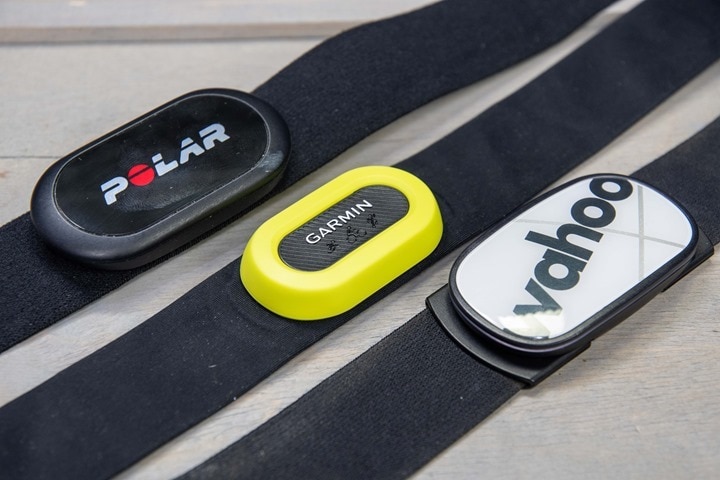
As usual, there's always lots of questions between these three models:
– Garmin HRM-PRO
– Polar H10
– Wahoo TICKR X 2020
Now, let's briefly look at the differences, but first, I'll just give you the TLDR: If you're a Garmin user, buy the Garmin strap. If you're anything else, then probably buy the Polar strap. The reason is relatively simple for Garmin users, because while the Wahoo TICKR-X supports offline workouts, Wahoo hasn't implemented the data offloading via ANT+ (they use their own internal app offloading process via Bluetooth Smart). And similarly, Polar hasn't implemented any offloading to watch (nor any running efficiency metrics).
If you aren't in the Garmin wearable ecosystem but still want data offloading, then you're deciding between the Polar H10 or Wahoo TICKR X, with an edge to the Polar H10 for stability/accuracy in my recent experience. Whereas if you want more of the TICKR X running efficiency metrics (such as with the Wahoo RIVAL), or because you want their offloading, splicing, and sync to partners. Except, my challenge recently is I've continued to have drop-out issues with the newer TICKR straps – something mirrored by regular readers and friends alike – hence why I pulled it from the most recent round-up of strap recommendations. Plus, Polar's strap is probably a bit more comfortable though for some people.
So essentially, unless you're a Garmin watch user – go with the Polar H9 or H10 (note: If you're a Garmin bike computer user, there's no meaningful difference between a Garmin strap and another company's strap). But yes, I know, I just pulled the Polar H9 into this fray out of left field all of a sudden. The simple differences are:
– Polar H9 only supports a single concurrent Bluetooth connection (but still supports ANT+)
– Polar H9 doesn't have onboard storage (remember, that requires the Polar Beat app for usage)
– The Polar H9 strap doesn't have the little bumpy traction things, though I often use the H9 and rarely notice the lack of them.
Make sense? Good.
Summary:
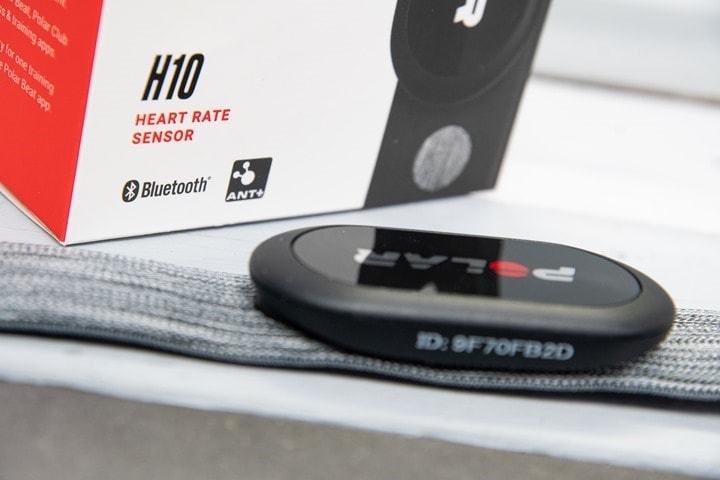
It'll come as no surprise that the Polar H10 is an accurate and reliable workhorse in the chest strap category. In many ways, that was never really a question. However, as always, it's something that's important to validate, and also to understand if or when there's any caveats. As noted, the caveats from an accuracy standpoint here are very minor, mostly limited to first getting warmed up and producing sweat. Other chest straps will generally suffer this same fate, and I noted easy moisture-driven mitigation steps to address that gap if you run into it. Wrist-based optical sensors don't tend to have that sort of start of workout warm-up issues unless your skin is cold, which unfortunately is harder to mitigate.
So if the challenge with the H10 isn't accuracy, then does the H10 have any issues at all? In some ways the only issue Polar has is Polar's own product: The less expensive H9. That has essentially equivalent accuracy in my testing, and costs less. It lacks the H10's onboard storage you probably won't use (because it's cumbersome to use), but also lacks the dual Bluetooth Broadcasting (that many also won't use). And then when comparing the H10 to their similarly priced competitors, Polar is in a bit of a pickle in terms of those higher-end features. If you're a Garmin user that wants advanced features, Polar can't fill in that gap. Same goes for Wahoo RIVAL users that want those features, or just want better workout offloading.
Still, for probably 95% of the remaining people out there (which, is a lot of people) – the Polar H10 is one of the best straps on the market, and arguably one of the most accurate sensors on the market, but also one that is comfortable to use and easy to swap the battery without subsequent issues with the strap. And for those that don't need the handful of extra features, the H9 can be had for a bit cheaper with the same level of accuracy in my testing.
With that – thanks for reading!
Found This Post Useful? Support The Site!
At the end of the day, I'm an athlete just like you looking for the most detail possible on a new purchase. These posts generally take a lot of time to put together, so if you're shopping for the Polar H10 or any other accessory items, please consider using the affiliate links below! As an Amazon Associate I earn from qualifying purchases. It doesn't cost you anything extra, but your purchases help support this website a lot. Even more, if you use Backcountry.com or Competitive Cyclist with coupon code DCRAINMAKER, first time users save 15% on applicable products!
And of course – you can always sign-up to be a DCR Supporter! That gets you an ad-free DCR, access to the DCR Quarantine Corner video series packed with behind the scenes tidbits...and it also makes you awesome. And being awesome is what it's all about!
Source: https://www.dcrainmaker.com/2021/12/polar-h10-heart-rate-monitor-very-long-term-in-depth-review.html
0 Response to "Continuous Heart Rate Polar Vantage Battery Life"
Post a Comment